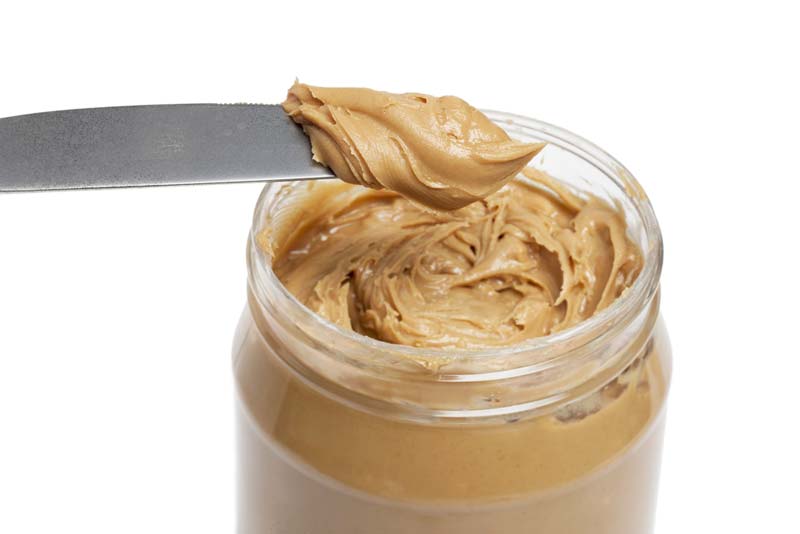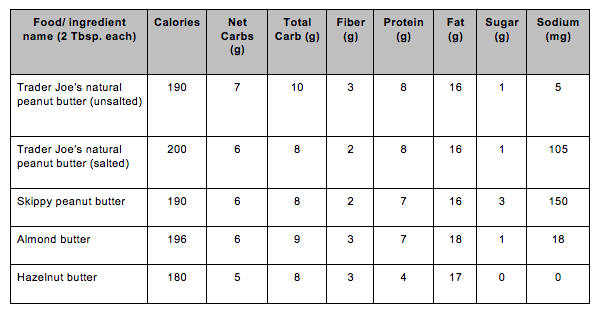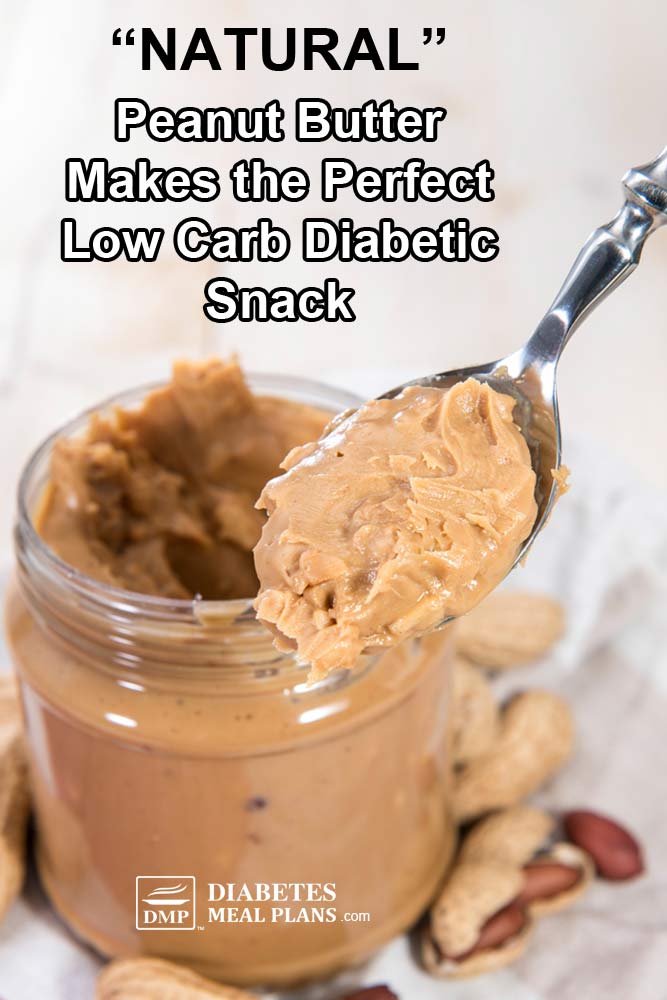Peanut butter is a food that’s close to so many of our hearts.
And nutrition guides often recommend veggies dipped in peanut butter as a healthy and satisfying snack.
But for diabetics, the important question is: is peanut butter low carb? And, how does it fit into a diabetic diet?

What is Peanut Butter?
Peanut butter is a thick, creamy substance that, in its simplest and healthiest form, contains only ground up peanuts.
However, some brands also add salt, sugar, and even hydrogenated fats, all of which make the butter a significantly less healthy food.
When choosing a peanut butter, it’s extremely important to read labels and always choose types with less ingredients, and look for butters labeled ‘natural,’ as these don’t contain all those nasty (and unnecessary) additives.
Peanuts themselves fall into both the ‘nut’ and the ‘legume’ category. They are thought to have originated in South America as early as 1500 B.C. Today, Americans eat more than 6 pounds of peanut products every year!
Peanut Butter Nutrition Facts
Peanut butter is not a low calorie food – 2 tablespoons of natural peanut butter contain 190 calories. But that doesn’t make it bad.
Being an energy-dense food simply means that a little bit goes a long way in terms of keeping you satiated (feeling full) for hours. For this reason, peanut butter consumption may actually help you lose weight by leading you to eat less overall.
If you’re wondering why peanut butter is so good at keeping you full, the answer lies in its high healthy fat, protein, and fiber content. Fat, protein, and fiber are pretty much the golden trio of satiation!
Two tablespoons of natural peanut butter contains 16 grams of fat (only 2 of which is saturated fat), 8 grams of protein, and 3 grams of fiber.
It terms of vitamins and minerals, peanut butter contains (per 2 tablespoons):
- 20% Recommended Daily Average (RDA) vitamin E
- 16% RDA magnesium
- 13% RDA potassium and vitamin B6
- 5% RDA iron
And yes, peanut butter is a low carb food!
Two tablespoons of natural peanut butter contain just 7 grams of carbs.
Nut Butters Compared
The discrepancies between natural and processed peanut butter varieties are fairly significant, as processed varieties often contain a lot more ingredients.
Let’s see how they stack up nutritionally, both against each other and against other kinds of nut butter.

As you can see, the nutrition facts for both ‘processed’ peanut butter, ‘natural’ peanut butter, and other kinds of nut butter are fairly similar.
However, let’s take a look at the differences in ingredients between natural and processed peanut butter…
Kraft peanut Butter ingredients: Select Roasted Peanuts, Soybean Oil, Corn Maltodextrin, Sugar, Hydrogenated Vegetable Oil (Cotton Seed And Rapeseed Oil), Salt, Mono- And Diglycerides.
Kroger’s creamy peanut butter ingredients: Roasted peanuts, sugar, gully hydrogenated vegetable oil (made of rapeseed, cottonseed and soybeans), salt, more sugar and honey.

Natural peanut butter ingredients: Peanuts!
Wow! As you can see, the processed kind of peanut butter contains a lot more ingredients, many of which (soybean oil, hydrogenated vegetable oil, and sugar) are better avoided!
As mentioned earlier, always read the labels and look for ‘natural’ peanut butter. All peanut butter really needs is peanuts!
Myths and Truths about Peanut Butter
Perhaps the most commonly discussed concern regarding peanut butter is the fear of peanut allergies. Many parents (or grandparents) aren’t sure what the best practice is to prevent peanut allergies in their children, and those who care for and spend time with people who have peanut allergies may not be sure what level of exposure is acceptable.
The short answer to the second concern is that the level of acceptable exposure to peanuts is different for everyone. Some people who are allergic may be able to eat off of a plate that has peanuts on it, while others may not even be able to kiss someone who has eaten peanuts. Make sure to find out what level of severity your loved one’s allergy is at!
Regarding peanut allergies, recent studies actually suggest that feeding your kids peanuts “early and often” is the best way to prevent the development of allergies. However, proceed with caution, nut allergies can be life threatening.

Research on Peanut Butter and Type 2 Diabetes
Studies suggest that nut and peanut butter consumption (one ounce serve [almost 2 Tbsp., 5 times per week) may lower the risk of developing type 2 diabetes.
If you already have type 2 diabetes, keep eating your peanut butter!
Frequent nut and peanut butter consumption has also been found to be associated with lower risk of cardiovascular disease and improves cholesterol profile, in women with type 2 diabetes. For nuts the dose was one ounce (28g), for peanut butter just 16 grams, or one tablespoon, 5 times a week.
Peanut and peanut butter consumption in adolescents has been found to be associated with lower weight, improved lipids, and a better overall diet.
Another study in obese women with risk of developing type 2 diabetes found that nut and peanut butter consumption (42.5 g) helps moderate post-meal glucose levels, enhances the secretion of gut hormones that promote satiety, and reduces the desire to eat.
Nut consumption has been shown to improve lipid levels and reduce inflammation without causing weight gain. These effects are thought to be partially due to nuts’ antioxidant and polyphenol content.
Resveratrol, a compound that has been found to prevent both the development and the proliferation of cancer, is also present in high levels in natural peanut butters.
So is Peanut Butter Good for Diabetics?
Yes, absolutely!!
Peanut butter is a low carb food that’s high in protein and healthy fats. As it’s an easy food to make a snack out of, it can be an integral part of a healthy diabetic diet.
You can simply load up a celery stick with peanut butter and chomp away. Or just load up a tablespoon and get gob-smacked with a pasty mouthful.
You can include peanut butter in sauces such as satay, or in recipes such as our popular Peanut Butter Protein Balls recipe.
And, make sure to always choose ‘natural’ varieties and avoid those long lists of unsavory ingredients!
Please pin, tweet or share this info to help others. Thanks. ;)


Pat Walkins
Yes. That’s a very good alternative . Somewhere I heard that any food with a barcode can’t be healthy for diabetics . I make all my nut butters minus sugar and added oil. They taste great
Emily - Dietitian (MS, RD)
Anything homemade is always a great choice! You are right that a majority of packaged foods (with barcodes) can be hit or miss in terms of your health, but if you shop carefully there are still some options you can include in your diet.
M.
How about PBfit? That is just powdered peanuts. Or recommending that people buy raw peanuts (bulk section of store), and grind their own peanut powder, or make their own peanut butter?
Emily - Dietitian (MS, RD)
Those would all be acceptable alternatives, although for some people that may be a bit labor intensive. Store bought peanut butter is absolutely fine to use, as long as you are selecting one without added sugar or processed oils.
Pam Brown
Why would anyone recommend hydrogenated anything with soybean or canola oil? There is a plethora of data showing the deleterious effects of seed and fake oils. 100% natural peanut butter contains nothing but peanuts and perhaps a little salt.
Emily - Dietitian (MS, RD)
Very true!
Noemia
Hi Jedha!
How about oat meal with low fat milk, for breakfast?
Jedha
We have some info on oatmeal here.
Patricia Teal
Thank you, for all the recipes and nutritional facts. I am a busy person and I’m looking for easy health recipes and I get that threw your emails.
Lydia Douglas
I also found and learned when your blood sugar has spiked just 1 tablespoon will bring it down. It did for me. Just like the hard boil egg trick.
Cindy Law
Love those little snack balls! I find that eating two is perfectly satisfying. It is hard to eat just one…but two is enough to fill the craving for something decadent.
jim
Thank goodness! If you had said it wasn’t good I’m afraid I might be looking for another site. Really, my favorite way to eat peanut butter is with veggie sticks. I haven’t tried a vegetable that doesn’t go well. Like so many things that are really good, portion control is critical. If you make celery sticks long enough you can even reach to the bottom of the jar. I haven’t dared try the little snack balls for fear I couldn’t stop eating them.